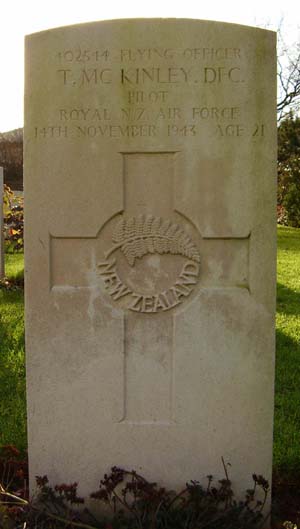On 14th November 1943 this 1652 Heavy Conversion Flight aircraft took off from Marston Moor to be given an airtest but soon after taking off the aircraft's two starboard engines failed, only three minutes after taking off and out of control the aircraft crashed into a brick lined pond behind the Vale of York Hotel by the side of the A59 road. Of the five people on the aircraft one was fortunate to have sustained only minor injuries while his four crew mates were sadly killed in the crash. The bodies of the four fatalities were taken into the pub as was the survivor prior to being taken to hospital. Much of the aircraft was left in the pond after the crash and remained in the pond for many years with the pond also having scrap cars and rubble being desposited in it. It was excavated in the mid-2000's and made into a wildlife area, during these works some pieces of the Halifax were dug out and were left on the site. The unit records for this date state that the weather was too poor to undertake any instructional flights day or night.
Halifax DG230 was built to contract ACFT/637/C4/C by Rootes Securities Ltd. at Speke and was taken on charge by 10 Squadron at Leeming on 26th July 1942. The squadron moved to Melbourne on 19th August 1942. As a result of operational battle damage on 27th September 1942 minor Cat.Ac/FB damage was the damage assessment and it was repaired on site with the repair complete by 31st October 1942. It was again slightly damaged by enemy action on the night of 9th / 10th January 1943 with Cat.B/FB damage being in the initial damage assessment that was swiftly downgraded to Re-Cat.A/FB the following day. The repairs after this incident were completed by 26th February 1943. The aircraft was then transferred to 1652 Heavy Conversion Unit at Marston Moor on 21st April 1943. On 14th November 1943 it crashed at Kirk Hammerton and was destroyed after which Cat.E2/FA damage was the damage assessment. It was struck off charge on 27th November 1943.
Pilot - F/O Terence McKinley DFC RNZAF (402544), aged 21, of Wellington City, New Zealand. Buried Harrogate Stonefall Cemetery, Yorkshire.
Second Pilot - S/Ldr Peter James Emerton RAF (37762), aged 26, of Sheerness, Kent. Buried Aldershot Military Cemetery (grave AA, 49).
Flight Engineer - P/O Norman Nice Beale RAFVR (53081), aged 22, of St Leonards on Sea. Buried Hastings Cemetery, Sussex (Div.M. Sec.F. Row F. Grave 24).
M.T. Driver / Passenger - AC1 George Henry Harrison RAFVR (1611886), aged 21, of Thurnscoe. Buried Dearne (Thurnscoe) Cemetery (Sec.J. Row B. Grave 41.)
Ground Crew / Passenger - AC2 Thomas Alan McCormack RAFVR (1629183). Minor injuries.


F/O McKinley and his gravestone at Harrogate Stonefall Cemetery. He had completed a Tour with 102 Squadron and was awarded his DFC for this, Gazetted on 17th August 1943. The citation stated that "he is an outstanding captain" and "his fine fighting spirit, courage and leadership have gained him the entire confindence of his crew." He was born in Nelson in 1922 and was working as a clerical cadet in the Government Housing Construction Dept. and had joined the RNZAF in July 1940. The photograph of him was kindly provided by air historian and author Mr Brian Lunn.
Peter Emerton received a commission in the RAF on 20th April 1936 to the rank of Acting P/O on probation. He was confirmed in the rank of P/O on 17th February 1937 and posted to 26 Squadron at Catterick on 1st May 1937. The date of when he rose to F/O is not yet known but he rose to F/Lt on 3rd September 1940 and to S/Ldr (temp) on 1st September 1941.
Norman Beale received a commission on 8th August 1943 to the rank of P/O on probation.

George Harrison's grave at Dearne. Photograph supplied by Brian Lunn.
I would like to thank Mr Phil McCormack for contacting me in April 2014 for kindly correcting his father's full name and for the additional information he was able to provide. Thomas McCormack enlisted for RAF service on 15th September 1942 and after training was posted to Marston Moor airfield as a member of ground crew. He spent a short time at the Rootes factory before returning to 1652 HCU/Marston Moor airfield. By the end of the war he had served as ground crew at East Kirkby, Coningsby, Holme on Spalding Moor, Melbourne and Honington. He apparently survived the crash of Halifax DG230 because he knew the aircraft was about to crash and positioned himself on the main spar of the aircraft, with this being the strongest section of the aircraft it worked and he survived. I understand that he was later given a good conduct award on 17th September 1945 and left the RAF in 1947. He died in 1995.

Remaining wreckage under a holly bush near the crash site that was photographed by Mr Ian Donnison who discovered the parts during a visit to a garden party held there in 2007.
Back.